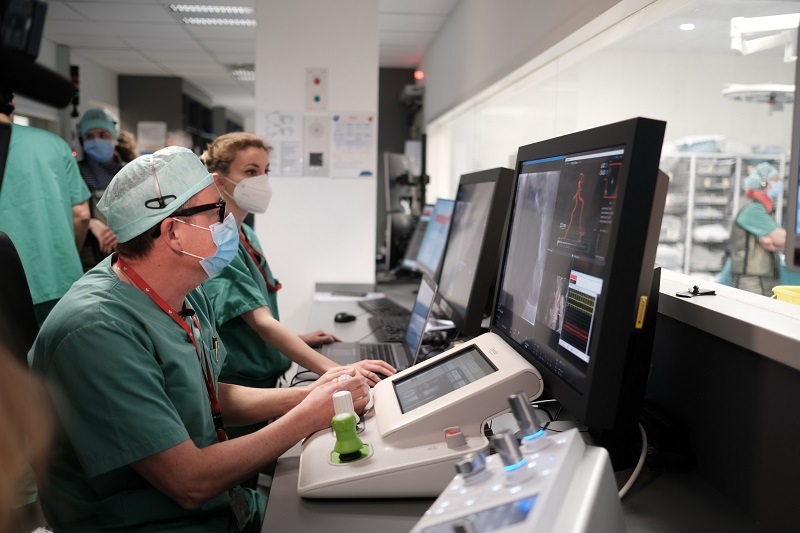Robotic systems have the potential to fundamentally change the way care is delivered to patients in the cath lab in coming decades. As the use of robotics becomes more prevalent, training the current and future generations of physicians to operate these systems is vital.
Alex Mottrie is the head of the Urology Department at the OLV Hospital (Aalst, Belgium) and the founder and chief executive officer of the Orsi Academy, a multidisciplinary centre for training and expertise in minimally invasive surgery. In this article, he and Eric Wyffels, interventional cardiologist and Chair of the Cardiovascular Centre at OLV Hospital, detail how the Orsi Academy is responding to this growing demand.
The pace of innovation in cardiovascular care—particularly the advancement of robotic-assisted capabilities—is providing growing benefits in patient care, but also creating demand for effective training for the people who work with the technology. To realise the inherent benefits of robotic technology, the healthcare ecosystem must reevaluate how we train physicians and technologists to maximise its reach.
Medicare spends about US$30 billion annually on hospital readmissions and more than half of that expenditure comes from potentially avoidable readmissions. By increasing access to training related to the latest innovations, we have an opportunity to mitigate some of those unnecessary expenses by raising the standard of patient care and making the most precise and effective technologies more widely available. The Orsi Academy in Belgium is a state-of-the-art facility dedicated to training and education programme for a variety of robotic technologies, and it has shown the benefit of devoting resources to hands-on training outside of the hospital setting.
By examining the model we use at Orsi and understanding the demands of training clinicians today, we can positively impact patient outcomes and combat unnecessary spending.
The standard of training is evolving with technology

Thirty years ago, young interventionalists trained in real catheterisation labs with real patients and residents had no restrictions on the number of hours they could spend in the cath lab. With the technology and resources available today, it is simply not acceptable to base physician training in the cath lab. With a facility such as Orsi, we can safely simulate the entire cath lab experience and allow for physicians to learn from mistakes without negatively impacting a patient.
Beyond just learning the functions of a robotic device, on-site training is also invaluable for creating cohesion among the team members involved in a robotic-assisted intervention. In addition to the learning curve for the physician operating the robot, nurses and technologists have unique responsibilities in a robotic-assisted procedure that differ from a manual procedure. A comprehensive simulated environment is an optimal way to support the care team as they learn their roles and safely gain experience and proficiency through repetitions in a controlled environment.
Prepare for an incoming wave of innovation
Robotic technology will experience more growth and innovation in the next 10 years than it did in the previous century. The “robot-isation” of healthcare is already underway and the wave of emerging technologies that complement robotic systems will only increase the demand for robotic capability. Those include automation, deep learning, artificial intelligence (AI), augmented reality (AR) and image-guided technology, and their progression will create more opportunity for training and education.
We have already seen a good example of a robotic platform that is evolving with new capabilities in the cardiovascular space. The Corindus CorPath GRX robotic system (Siemens Healthineers) is used for percutaneous coronary and vascular procedures and has added new automated movements to its technology since it first became commercially available. As those capabilities continue to evolve, having a dedicated training facility at Orsi allows for physicians and their colleagues to stay informed on the latest developments and continue to train on new devices.
Much to gain from expanded robotics

There is no denying the level of excitement around the potential for robotic-assisted platforms to positively impact patient outcomes. In addition to making procedures more precise and limiting radiation exposure for both the patient and physician, platforms such as CorPath GRX have shown potential to increase access to high-level care through remote robotic intervention. However, those capabilities will not reach their full potential if the healthcare system does not expand its capacity for training on a global scale—and the stakes are high in healthcare.
We are in the midst of a “great resignation” that has come to a crescendo thanks to a combination of physician burnout and staffing issues that were magnified by the COVID-19 pandemic. Against that backdrop, robotic technology presents an opportunity to make our healthcare system more efficient and it may help to solve some of the patient load management issues that have characterised much of the previous two years in our hospitals. By placing stents and other devices with robotic precision, we can minimise the chances of patients needing a readmission and keeping patients out of the hospital has never felt more important in recent memory.
Alex Mottrie and Eric Wyffels report no relevant financial disclosures.










